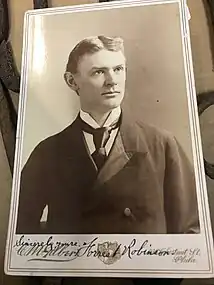
Forrest Robinson (1858 – January 6, 1924) was an American stage and silent era actor.[1] He was a leading man at the Boston Museum Theater and acted in numerous theatrical productions in New York.[2][3] He also appeared in numerous films.
Forrest Robinson | |
|---|---|
_poster.jpg.webp) Poster for From Two to Six (1918) | |
| Born | 1858 |
| Died | January 6, 1924 (aged 65–66) |
| Nationality | American |
| Occupation | Actor |
| Spouse | Mabel Bert |
Robinson was in the Broadway productions Sag Harbor (play) (by James A. Herne and with Lionel Barrymore) at the Republic Theatre in 1900;[4] Fortune-Hunter (by Winchell Smith and with John Barrymore) in 1909 at the Gaiety Theatre;[5] The Master of the House[6] at the 39th Street Theatre in 1912; John Cort's The Iron Door in 1913; and Philip Moeller's production of Molière in 1919 at the Liberty Theatre.[7] Robinson toured London's West End in 1914 with Smith's Fortune-Hunter. The critic, Boyle Lawrence, described Robinson's performance in the Pall Mall Magazine Mr. Forrest Robinson, as an inventor, acted charmingly. Without any trace of effort, he projected a real, lovable personality over the footlights.[8]
Robinson's silent film career included starring with Winifred Allen in From Two to Six (1918). His role in Tess of the Storm Country was described in the New York Times saying he '"gives the character of simplicity to Tess's father".[9]
Robinson was married to the actress Mabel Bert.[10]
Theater
- Love Finds the Way (1896)
- Sag Harbor (1900)[4]
- Fortune-Teller (1909)[5]
- The Master of the House (1912)[6]
- The Iron Door (1913)[11]
- East Meets West (1918)
- Molière (1919)[7]
Filmography
- The House of a Thousand Candles (1915 film) as Bates
- The Dawn of a Tomorrow (1915 film) as Sir Oliver Holt
- The Mating (1918)
- Little Miss Hoover (1918) as Colonel William Craddock
- Just a Woman (1918 film) as Judge Van Brink
- From Two to Six (1918)
- His House in Order (1920 film)
- Tol'able David as Grandpa Hatburn
- Tess of the Storm Country (1922 film)[12] as Orn 'Daddy' Skinner
- Adam's Rib (1923 film) as Kramer
- Ashes of Vengeance (1923) as Father Paul
- Souls for Sale (1923) as Rev. John Steddon, Mem's father
- When a Man's a Man (1924 film) as The Dean
References
- ↑ Klepper, Robert K. (September 16, 2015). Silent Films, 1877-1996: A Critical Guide to 646 Movies. McFarland. ISBN 9781476604848 – via Google Books.
- ↑ "Forrest Robinson". The New York Times. 8 January 1924. p. 23.
- ↑ "Forrest Robinson – Broadway Cast & Staff | IBDB". www.ibdb.com.
- 1 2 "Sag Harbor". Oxford Reference.
- 1 2 "Fortune-Hunter Delightful Comedy". The New York Times. 5 September 1909.
- 1 2 "39th Street Theatre", Theater, Meyer Bros. & Company, vol. 16, 1912
- 1 2 Hornblow, Arthur (May 1919), "Mr. Hornblow Goes to the Play", Theatre Magazine, Theatre Magazine Company, vol. 29
- ↑ Lawrence, Boyle (1914). "The Theatre". Pall Mall Magazine. Vol. 53, no. 251. pp. 363–372. ProQuest 6390168.
- ↑ "Rough Matrimonial Weather". The New York Times. 13 November 1922. p. 20.
- ↑ "Information - 17 Oct 1934, Wed • Page 17". Oakland Tribune: 17. 1934. Retrieved 2 October 2017.
- ↑ "John Cort Shows The Iron Door". The New York Times. 30 January 1913. p. 11.
- ↑ "Hollywood". May 19, 1922 – via Google Books.